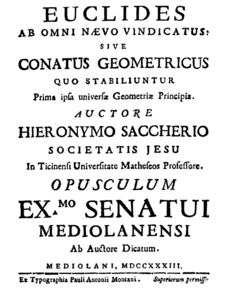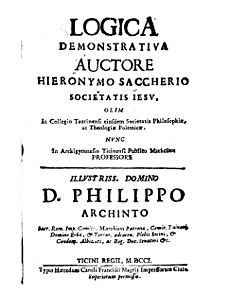Giovanni Girolamo Saccheri facts for kids

Giovanni Girolamo Saccheri was an Italian Jesuit priest and a brilliant mathematician. He was born in Sanremo, Italy, on September 5, 1667.
Saccheri joined the Jesuit order in 1685 and became a priest in 1694. He taught important subjects like philosophy and mathematics. He worked at the University of Turin from 1694 to 1697. Later, he taught at the University of Pavia from 1697 until he passed away on October 25, 1733. He wrote several books during his life, including Quaesita geometrica (1693) and Logica demonstrativa (1697).
Contents
Saccheri's Big Idea in Geometry
Saccheri is best known for his last book, published in 1733. It was called Euclides ab omni naevo vindicatus, which means Euclid Freed of Every Flaw. This book explored new ideas in geometry that were very different from what people believed at the time. His work was forgotten for a long time until it was rediscovered in the mid-1800s.
Challenging Euclid's Parallel Rule
Saccheri wanted to prove that Euclid's rules for geometry were completely correct. One of Euclid's rules is called the parallel postulate. This rule talks about parallel lines. Saccheri tried to prove it was true by showing that if it were false, it would lead to something impossible. This method is called reductio ad absurdum.
Euclid's parallel postulate is like saying that the angles inside any triangle always add up to 180 degrees. Saccheri wondered what would happen if this wasn't true.
What if Angles Add Up Differently?
Saccheri looked at two main possibilities:
- What if the angles in a triangle added up to more than 180 degrees?
- What if the angles in a triangle added up to less than 180 degrees?
When Angles Add Up to More
If the angles added up to more than 180 degrees, Saccheri found that straight lines would have to be a certain length, not endless. This went against another one of Euclid's basic rules. So, Saccheri correctly decided this idea was wrong for normal geometry.
However, today we know this idea is the basis for a type of geometry called elliptic geometry. In this geometry, lines are not endless, and they can even meet in more than one place.
When Angles Add Up to Less
The second possibility was much harder to prove wrong. If the angles added up to less than 180 degrees, Saccheri couldn't find a clear contradiction. Instead, he found many strange results. For example, he found that triangles would have a maximum size, and there would be a special unit of length.
He eventually decided that this idea was also wrong. He thought it didn't fit with how straight lines naturally behave. But today, we know that the results he found are actually true in a different kind of geometry called hyperbolic geometry.
Some people wonder if Saccheri truly believed his own conclusion. He was very close to discovering these new types of geometry. Some think he might have said his findings were wrong to avoid criticism from other mathematicians.
Saccheri Quadrilateral
In his work, Saccheri used a special shape now called a Saccheri quadrilateral. This shape has two equal sides that are perpendicular (at right angles) to a base. The top angles are then studied.
An earlier version of this shape was used by a Persian scholar named Omar Khayyám in the 11th century. However, Saccheri explored the ideas from this shape much more deeply than anyone before him.
See also
 In Spanish: Giovanni Gerolamo Saccheri para niños
In Spanish: Giovanni Gerolamo Saccheri para niños
- Saccheri–Legendre theorem
- Hyperbolic geometry
- Parallel postulate
- List of Jesuit scientists
- List of Roman Catholic cleric–scientists
Images for kids




